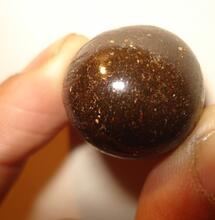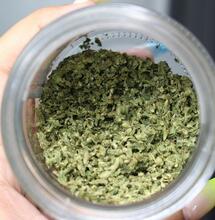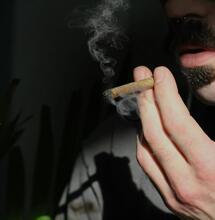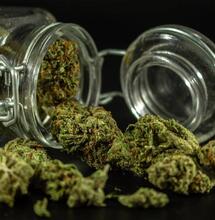The History of Music and Marijuana (Part One)
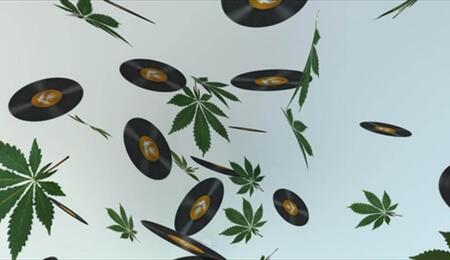
Louis Armstrong Jazz and Mary Warner The 20th century stories of music and marijuana both begin in Storyville, the red light district of New Orleans. This is where Louis Armstrong was born in 1901, and where the first recorded American use of “marihuana” occurred in 1909.
According to cannabis historian Ernest Abel, “It was in these bordellos, where music provided the background and not the primary focus of attention, that marihuana became an integral part of the jazz era. Unlike booze, which dulled and incapacitated, marihuana enabled musicians whose job required them to play long into the night to forget their exhaustion. Moreover, the drug seemed to make their music sound more imaginative and unique, at least to those who played and listened while under its sensorial influence.”1 Growing up in this milieu, as Armstrong told his biographers, much later, “We always looked at pot as a sort of medicine, a cheap drunk and with much better thoughts than one that’s full of liquor.”2 Jazz and swing music was declared to be an “outgrowth of marihuana use” by the white authorities. They expressed concern that itinerant black musicians were spreading a powerful new “voodoo” music and that they also sold the weed which made decent folks abandon their inhibitions. According to music historian Harry Shapiro, “In the early 20’s, marihuana, muggles, muta, gage, tea, reefer, grifa, Mary Warner, Mary Jane or rosa maria was known almost exclusively to musicians.”3 Since smoking marijuana was associated with wild music and crazy behavior ? and with Negroes and Mexicans ? the Man moved quickly to stamp it out, conducting a racist press campaign that was to set an unseemly precedent for all the anti-pot propaganda to come.
New Orleans banned the weed in 1923 and all Louisiana followed suit in 1927. Official disapproval of pot didn’t become an issue for Louis Armstrong until one night in 1931, when he was busted while blasting a joint between sets in the car park of the Cotton Club in Culver City, near Hollywood. The cops were pretty decent about it, being fans of the great man, but a rival band leader had dropped a nickel on Satchmo and they were obliged to take him downtown, where he spent nine days in the Los Angeles City Jail. The first genius of jazz faced a possible sentence of six months, but the judge turned out to be a fan, too, and gave him a suspended sentence. “I went to work that night ? wailed just like nothing happened. What struck me funny though ? I laughed real loud when several movie stars came up to the bandstand while we played a dance set and told me, when they heard about me getting caught with marijuana they thought Mary Warner was a chick. Woo, boy ? that really fractured me!” Experience taught Satchmo to be reticent about his fondness for sweet Mary Warner and he never recounted the story of his bust until shortly before his death in 1971, when he agreed to “tell it like it wuz” for his biographers. “We did call ourselves Vipers,” he admitted, “which could have been anybody from all walks of life that smoked and respected gage. That was our cute little name for marijuana…” Louis Armstrong was the foremost celebrity, or “King” of Harlem ? the capital city of black America ? over the period when the early jazz scene spawned numerous recordings that referred to marijuana.
The Rolling Stones and John LennonDance of the vipers “When I came to New York in 1937,” wrote Dizzy Gillespie in his autobiography, “I didn’t drink nor smoke marijuana. ‘You gotta be a square muthafucka!’ Charlie Shavers said and turned me on to smoking pot. Now, certainly, we were not the only ones. Some of the older musicians had been smoking reefers for 40 and 50 years. Jazz musicians, the old ones and the young ones, almost all of them that I knew smoked pot, but I wouldn’t call that drug abuse.” References to marijuana, under various aliases, abound on early recordings with titles like Tea for Two, Lotus Blossom and Smoking Reefers, many of which have now been reissued on American compilation albums with titles like Reefer Songs and Viper Mad Blues. Conjure the image of the hissing viper for a second: taking a swift, sly suck on a skinny little joint. A viper is a toker, which practically all jazz musicians were, and the viper songs celebrated a new social hero: the dude who supplied the inspirational but illegal herb that made the rent parties go with a swing. Satchmo was surrounded by a crowd of vipers that included a cat by the name of Milton “Mezz” Mezzrow, a Jewish kid from Chicago who started hanging out with black musicians he met at the reformatory and resolved to “become” a Negro. First Mezzrow learned to play the horn, and pretty soon he was getting high with the boys in the band. During the Roaring Twenties, Mezzrow played in the speakeasies that proliferated in Capone-era Chicago.
As Prohibition ended and the Depression set in, Mezz achieved his goal by moving to Harlem, the capital city of black America. On arrival, he found the local reefer to be decidedly ropy and, if he couldn’t compete with the talented local musicians, he certainly knew where to score superior weed. Mezz used his powerful Mexican loco-weed as a way into a community where he was desperate to be accepted and the community embraced him so warmly that, before long, his name had become a byword for good quality marijuana. Mezz was the toast of Harlem! That the great Fats Waller was a mighty good friend of Mezz’s cannot be doubted, for so he testified on If You’re A Viper: “Dreamed about a reefer five foot long/ Mighty Mezz but not too strong/ You’ll be high, but not for long/ If you’re a viper.” The BeatlesTime dilation Mezzrow’s own contribution to the canon of pot songs is a tune called Sendin’ the Vipers, but his musical legacy is eclipsed by his autobiography, Really the Blues,4 which vividly recalls the early jazz era and contains this account of the effect of the first joint he ever smoked had upon his skills as a musician: “The first thing I noticed was that I began to hear my saxophone as if it was inside my head… Then I began to feel the vibrations of the reed much more pronounced against my lip and my head buzzed like a loudspeaker.
I found I was slurring much better and putting just the right feeling into my phrases. I was really coming on. All the notes came easing out of my horn like they’d already been made up, greased and stuffed into the bell, so all I had to do was to blow a little and send them on their way, one right after the other, never missing, never behind time, all without an ounce of effort.” Compare these words to the testimony of one Dr James Munch, a pharmacologist who was the top official expert on the effects of marijuana in the US throughout the 1930’s and 40’s and a close associate of the Commissioner of the Federal Bureau of Narcotics, Harry J Anslinger, who was chiefly responsible for prohibition. Years after the fact, Dr Munch was quizzed by Larry “Ratso” Sloman, author of a popular social history of marijuana use in America, Reefer Madness. Ratso asked him why Anslinger went after musicians who smoked pot: “Because the chief effect as far as they were concerned was that it lengthens the sense of time, and therefore they could get more grace beats into their music than they could if they simply followed the written copy… In other words, if you’re a musician, you’re going to play the thing the way it’s printed on a sheet. But if you’re using marijuana, you’re going to work in about twice as much music between the first note and the second note.
That’s what made jazz musicians. The idea that they could jazz things up, liven them up, you see.”5 So Anslinger hated marijuana for the same reason jazz musicians loved it! One of the reasons Anslinger was motivated to stop people smoking pot in the first place was because it inspired unconventional jazz music! Even after he’d managed to get marijuana banned in 1937, Anslinger was so vexed by pot-smoking musicians that he instructed his agents across the country to keep an eye on all local jazz musicians and prepare for the day when they would all be rounded up in one fell swoop!6 The planned Jazz Pogrom was abandoned in 1948, when Anslinger went before a Congressional Committee to plead for more funds to carry out his dastardly plan and shot himself in the foot: newspaper reports of his denunciation of jazz musicians prompted thousands of letters of objection from the jazz-loving American public. Fats WallerMalcolm X as Staggerlee In 1943, before he transformed himself into Malcolm X, a crazy seventeen-year-old hepcat who travelled by the handle of Detroit Red came to Harlem looking for a hustle and wound up “peddling reefers” to the jazz musicians he idolized. “In every band, at least half the musicians smoked reefers,” he told Alex Haley 20 years later. “I’m not going to list names; I’d have to include some of those most prominent in popular music, even a number of them around today. In one case, every man in one of the bands, which is still famous, was on marijuana.” Malcolm told how he would score through a friend called Sammy and sell ready-rolled joints (or “sticks” since they were no bigger than matchsticks) “wherever musicians congregated.”
When Harlem got too hot, Crazy Red hit the road. “I’d turn up in towns were my friends were playing. ‘Red!’ I was an old friend from home. In the sticks, I was somebody from the Braddock Hotel. ‘My man! Daddy-o!’ And I had Big Apple reefers.”7 In Mystery Train, his classic collection of essays about American rock and roll, Greil Marcus explores the myth of Staggerlee, the boldest, baddest black man on the block. No slave he, Staggerlee is the archetypal glamorous outlaw: flashily dressed, not to be crossed, and living for kicks. Or, as Marcus quotes Bobby Searle, a leading member of the Black Panthers: “Staggerlee is Malcolm X before he became politically conscious. Livin’ in the hoodlum world.”8 Indeed, the conked and Zoot-suited, Lindy-hopping Harlem Red might well have been the Reefer Man Cab Calloway sang about. Long before he became the most radical black politician of his generation, Malcolm X personified white middle America’s worst nightmare: an uppity nigger who didn’t know his place and openly consorted with white women. In fact, Harlem Red conformed only too closely to the image of the evil pusher portrayed by the anti-pot propaganda of the era. Portrayed in popular songs as romantic heroes, drug dealers were condemned by prohibitionist propaganda as wicked villains, hell-bent on corrupting the innocent and destroying young lives.
Dizzy GillespieThe great divide The great divide between straight and stoned yawned widest ? according to legend ? in the 1960’s. The prophet of the decade was Bob Dylan, who sang in nasal whine garbled lyrics that defied interpretation even to those who had ears to hear them. What Dylan was singing about was open to conjecture, but to begin to appreciate him required an ability to tune into his words without being distracted by his terrible singing. Listen to Dylan while under the influence of marijuana, however, and his caterwaul starts to make some kind of sense. One effect of being stoned that Charles T Tart describes as “very characteristic” is an ability to understand the words of songs which are not clear when straight. This, Tart notes, tartly, “is an experience clearly relevant to understanding rock music, which seems incomprehensible to many ordinary people.”9 Dylan himself explained it rather more forcefully in the refrain to Rainy Day Women #12 & 35: “Everybody must get stoned!” The Swingin’ Sixties officially kicked off on August 28, 1964, when Bob Dylan met the Beatles in their hotel suite during their first visit to New York and turned them on to pot. Paul McCartney told Barry Miles how Ringo took Dylan’s proffered reefer and ? not knowing that etiquette dictates that the skinny cigarette be passed around ? smoked the whole thing.10 From that day forward, throughout what is universally accepted to be the most creatively fertile period of any pop group in history, the Beatles were stoned out of their ever-expanding minds on a daily basis. Any and every mention of “high” or “grass” or “smoke” in a Beatles song, said Paul, was always intentional.
By the time they made Help, at the height of Beatlemania in the Summer of ’65, according to John Lennon: “The Beatles had gone beyond comprehension. We were smoking marijuana for breakfast. We were well into marijuana and nobody could communicate with us, because we were just glazed eyes, giggling all the time.”11 Ever the rebel, Lennon claimed that the Fab Four had even shared a furtive joint in the loo at Buckingham Palace when they went to collect their MBEs in October, 1965 (although George Harrison’s more recently revealed memory was that it was just a straight ciggy). In 1968, John Lennon, aged 28, was fined ?150 for possession of 219 grains (about half an ounce) of cannabis resin, a conviction that weighed heavily against him in later years when he sought to become a US resident. John’s old mucker, Macca, also had hassle with the law, most famously at Tokyo Airport in 1980, when he was caught carrying 219 grams (nearly half a pound) of cannabis through customs and was subsequently deported from Japan after spending nine days in jail. Paul McCartney didn’t learn his lesson, though, and in 1984, at the ripe old age of 42, the multi-millionaire musician and confirmed family man faced his fourth prosecution for possession of cannabis in a glittering career that has led to a knighthood (and beyond). In 1972, Lester Grinspoon appeared as an expert witness on John Lennon’s behalf. Grinspoon testified at the hearings that the US Attorney General had engineered as a way of getting John and Yoko Ono out of the country on marijuana charges, after they had become involved in anti-Vietnam War activities. Over dinner, Grinspoon recalls, “I told John… how cannabis appeared to make it possible for me to ‘hear’ his music for the first time in much the same way that Allen Ginsberg had ‘seen’ Cezanne for the first time when he purposely smoked cannabis before setting out for the Museum of Modern Art, to determine if he could, with the help of marijuana, break through his incapacity to relate to Cezanne.
John was quick to reply that I had experienced only one facet of what marijuana could do for music, that he thought it did wonders for composing and making music as well as listening to it.”12 DonovanHigh-profile punishments Donovan, the UK’s home-grown, hippy-dippy Dylan surrogate who was fined for possessing marijuana in July 1966, was one of the first to have to suffer a lecture from a pompous judge about his status as a role model for young people. The prurient British press, ever ready to perceive a threat to decent society, joined the chorus of disapproval and stoked the fires of moral outrage. The campaign against those pop stars denounced by the Daily Mail for their “decadence” reached its zenith with the police raid on Redlands, Keith Richards’ house in West Sussex, in February 1967. Tipped off by The News of The World, the officers discovered a small, stoned party in progress that included a young woman ? singer Marianne Faithfull, enticingly referred to in press reports as “Miss X” ? stark naked under a fur rug and allegedly under the influence of marijuana. At the trial, the judge directed the jury to disregard Faithfull’s evidence that she hadn’t been smoking pot at the time, and sentenced Richards to 12 months in prison, plus costs, for allowing his house to be used as a venue for smoking what the law quaintly referred to as “Indian hemp.” At the same time, Mick Jagger, the Rolling Stones’ ringleader and Parental Enemy No. 1 of the period, was given three months for possessing four pep pills that had been purchased perfectly legally in Italy. This blatant injustice prompted the famous editorial column Who breaks a butterfly on the wheel? in The Times on July 1, 1967. While quoting William Blake and denouncing the phenomenon of social revenge in which “a single figure becomes the focus for public concern about some aspect of public morality,” author William Rees-Mogg failed to mention marijuana. Indeed, he pointed out that “Mr Jagger was not charged with complicity in any other drug offense that occurred in the same house.”
While the injustice done to Jagger may have appeared more clear-cut, the omission of any mention of his partner in crime, Richards, was pertinent. The only person found in possession of cannabis at Redlands was a Canadian drug dealer named David Scheidermann, who had since disappeared and whom Richards had denounced from the witness box during his trial as an informer planted by The News of the World in order to entrap the Stones. Although Keith was facing a year’s incarceration for doing nothing, his debauched image was deemed to be less defensible. On appeal, however, the evidence relating to the naked girl was deemed to be “extremely prejudicial” and the case against Keith Richards was quashed. Mick Jagger was given the standard lecture about being a responsible role model and let off with a conditional discharge. On July 24, 1967, an advertisement appeared in The Times declaring that “the law against marijuana is immoral in principle and unworkable in practice,” signed by more than 60 luminaries of the time. Jonathan Aitken, the disgraced Tory politician, was top of the alphabetical list, followed by Tariq Ali. Also featured were such familiar names as David Dimbleby, Herbert Kretzmer, George Melly, and all four members of the Beatles. The ad, placed by an organization called SOMA (after Aldous Huxley’s euphoriant in Brave New World) cited medical opinion that cannabis is innocuous, quoted Spinoza (“All laws which can be violated without doing anyone any injury are laughed at”) and proposed a five-point plan for the repeal of cannabis prohibition.
At that time, no more than half a million people in Britain had actually tried cannabis. The London drug scene of the 60’s, in which the Beatles and the Stones were lauded like sheiks, was an exclusive club where the in-crowd understood that true wealth is not calculated in terms of material possessions, but in love, peace and the kind of chemically-enhanced consciousness that was being proselytized by the American academic turned Acid Guru, Timothy Leary.Donovan
